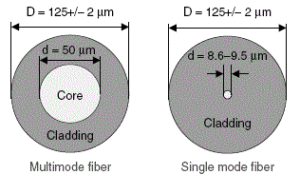Fiber optic cables are now being used in a wider variety of applications than ever before. There are two types of fiber – Single mode and Multi mode. Most people know that single mode fiber is more popular for longer distances while multi-mode is preferred for shorter links, but what is the real difference? We try to shed some light on the technical difference between single and multi-mode fibers.
Let us take a closer look inside a fiber optic cable. Fiber is essentially a hair-thin strand of glass. The core and cladding are usually made of ultra-pure glass.


It is all in the Mode
Mode is the path that light travels. Due to the narrow core of the single-mode fiber, light travels in a single path through it while in a multi-mode fiber, light travels in many path


In multi-mode fiber, some of the light travels in a direct route while others bounce off the walls. Because of this high dispersion rate, the quality of the signal degrades over longer distances.
Cost Equipment cost plays an important role when calculating deployment costs. Single-mode fiber requires a light source with narrow spectral width making single-mode transceivers and equipment more expensive. Multi-mode fibers typically use low-cost light sources like LEDs or VCSELs.
Color Single-mode fiber is usually yellow in color. Multi-mode cables come in different types depending on core dia. and bandwidth– OM1, OM2, OM3, OM4, and OM5. OM1 and OM2 fibers are usually orange, OM3 aqua, OM4 aqua or pink and OM5 lime green.
GKoptic supplies a large array of single-mode and multi-mode fiber cables. If you have any questions, please contact us at sales@gkoptic.com .


